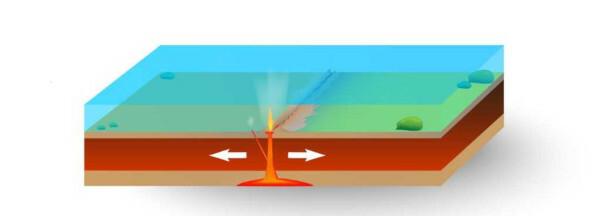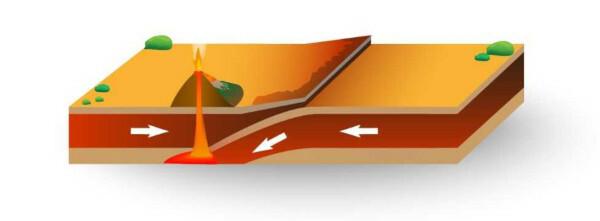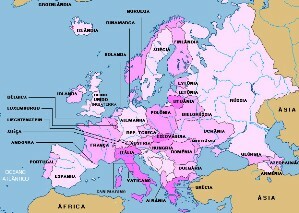Tectonic plates are large, semi-rigid rock blocks that make up the earth's crust. The Earth is divided into fourteen main tectonic plates, which move over the mantle in a slow and continuous way, being able to approach or move away from each other.
THE plate movement results in the formation of mountains, ocean trenches, volcanic activity, earthquakes and tsunamis.
Plate Tectonic Theory
In 1913, Alfred Wegener introduced the Continental Drift Theory, which states that millions of years ago the Earth's masses formed a single supercontinent, called Pangea. This theory was confirmed by its successor, the so-called Plate Tectonic Theory.
The tectonic plate theory assumes that the earth's crust is divided into large semi-rigid blocks, that is, into plates that cover the continents and the ocean floor. These plates move over the magma, driven by forces coming from deep within the Earth. Therefore, the earth's surface is not an immobile plate, as it was spoken in the past.
Main tectonic plates
Planet Earth is divided into 52 tectonic plates, 14 major and 38 minor. As examples of main plates, we can mention the South American plate, the Pacific plate and the Australian plate. The smaller ones can be exemplified by the North Ande Plate, Carolina Plate and Marianas Plate.
See below the characteristics of some of the main tectonic plates that make up our planet:
Tectonic plate |
Location |
South American Plate |
It covers South America and extends to the Mid-Atlantic Ridge. Its eastern border makes a divergent boundary with the African Plate; to the south, it borders the Antarctic Plate and the Scotia Plate; to the west, it forms a converging boundary with the Nazca Plate; and to the north, it borders the Caribbean Plate. |
Nazca plate |
It is located to the left of the South American Plate. The clash between these two plates formed the Andes Mountains. |
Pacific plate |
It covers much of the Pacific Ocean. It is limited to the north by the Placa do Explorer, the Placa Juan de Fuca and the Placa de Gorda. His limit with the North American Plate resulted in the failure of San Andres. |
Eurasian plate |
It covers part of Eurasia and borders the African Plate and the Indian Plate. It separates from the North American Plate by the Mid-Atlantic Ridge. |
Types of boards
Oceanic: are found on the ocean floor.
Continentals: lie under the continents.
Oceanic and continental: lie under the continent and on the ocean floor.
Mind Map: Tectonic Plates

*To download the mind map in PDF, Click here!
Why do tectonic plates move?
The movements performed by tectonic plates occur due to the high temperatures existing inside the Earth.
The earth's crust lies on the cloak, Earth's layer composed of magma. The intense heat causes the circular movement of the mantle in convection currents. This convective movement transfers heat from the core (the Earth's innermost layer) to the outermost layers, causing the plates to move, leading to the joining or separation of the continents.
Read too:Earth layers
tectonic plate movements
The movement of the plates is slow, continuous and takes place at the boundary between them. This displacement takes a long time and is responsible for several transformations and phenomena that occur in the earth's crust, such as the formation of mountains and volcanoes, earthquakes and agglutination or separation of continents.
The movements of the tectonic plates can be lateral, retraction and collision.
Do not stop now... There's more after the advertising ;)
Limits of tectonic plates
Limits of tectonic plates correspond to the areas where the plates meet, that is, they are the borders or margins of plates, in which there is intense movement, such as seismic activities and volcanism.
Read too:What is the relationship between volcanism and plate tectonics?
1) Divergent limit
on the move divergent, at plates move away from each other, forming cracks and cracks in the earth's crust. Thus, when the movement of the ascending convective currents occurs, the magma from the Earth's interior crosses the cracks, being carried to the surface. The magma then cools and is added to the edges of the plates, which increase in size.
The separation of oceanic plates gives rise to mid-ocean ridges (mountain ranges submerged in the ocean), which cause expansion of the ocean floor, causing earthquakes and volcanoes. The separation of continental plates, on the other hand, can lead to earthquakes and form volcanoes and rift valleys (regions where the earth's crust suffers a fracture, causing it to move away from neighboring portions of the earth's surface), such as those found in the Gulf of California.

In the divergent movement, the tectonic plates move away from each other.
2) Convergent limit
on the move convergent, at plates approach and crash into each other. When the converging movement occurs between an oceanic plate and a continental plate, the first one returns to the mantle, while the second one wrinkles, forming folds. This is because rocks on oceanic plates are denser than rocks on continental plates.
When there is a collision between two oceanic plates, only one of the plates will sink, in this case, the denser of the two.
When the collision occurs between two continental plates, there is no sinking of the plates, since the density of the two is the same, therefore, both suffer from folding. An example of this type of clash was what occurred between the South American plates and the Nazca Plate, which gave rise to the Andes Mountains.

In the convergent movement, the tectonic plates approach and collide with each other.
3) Transforming limit
on the move transformant, at plates slide in relation to each other, causing cracks in the contact region between the plates. In this movement, there is no destruction or creation of plates, which can, in some cases, lead to failures.
A great example of transformative movement occurred between the Pacific Plate and the North American Plate, resulting in the San Andres Fault in the US state of California.

In the transforming movement, the tectonic plates slide relative to each other.
Plates in Brazil
O Brazil is located in the center of South American Plate, which has an area of 43.6 million square kilometers and approximately 200 kilometers thick. This plate moves west, away from the Mid-Atlantic Ridge and toward the Nazca and Pacific Plates.
As it is located exactly in the center of the South American Plate, Brazil hardly suffers major shocks. There are occurrences of small magnitude earthquakes in the country, resulting from plate wear.
Know more:Volcanism in Brazil
By Rafaela Sousa
Graduated in Geography
The movement caused by the clash between the Nazca and South American Tectonic Plates caused the appearance:
a) from the South American continent.
b) the mountain ranges of Mexico.
c) of the Andes Mountains.
d) of the Himalayan Mountains.
About the San Andreas Fault, located in California (USA), we can say that:
a) it is the result of the intense earthquakes that devastate the region.
b) its origin is related to the collision and uplift movement between two tectonic plates.
c) its formation is not related to plate tectonics, as it only manifests on the earth's surface.

